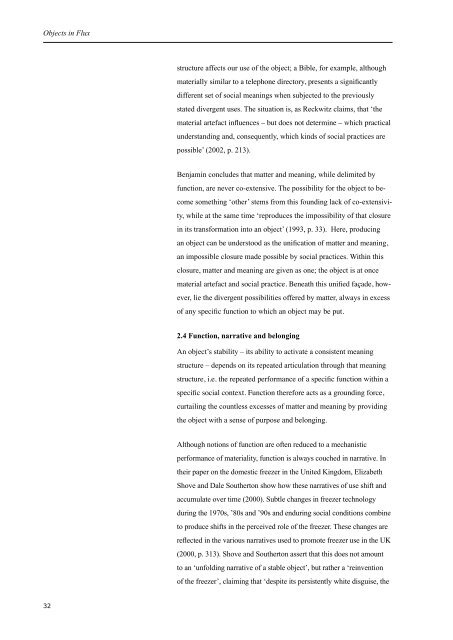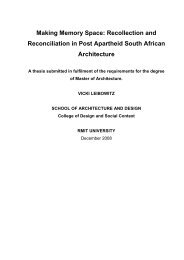Objects in Flux - RMIT Research Repository - RMIT University
Objects in Flux - RMIT Research Repository - RMIT University
Objects in Flux - RMIT Research Repository - RMIT University
Create successful ePaper yourself
Turn your PDF publications into a flip-book with our unique Google optimized e-Paper software.
<strong>Objects</strong> <strong>in</strong> <strong>Flux</strong><br />
32<br />
structure affects our use of the object; a Bible, for example, although<br />
materially similar to a telephone directory, presents a significantly<br />
different set of social mean<strong>in</strong>gs when subjected to the previously<br />
stated divergent uses. The situation is, as Reckwitz claims, that ‘the<br />
material artefact <strong>in</strong>fluences – but does not determ<strong>in</strong>e – which practical<br />
understand<strong>in</strong>g and, consequently, which k<strong>in</strong>ds of social practices are<br />
possible’ (2002, p. 213).<br />
Benjam<strong>in</strong> concludes that matter and mean<strong>in</strong>g, while delimited by<br />
function, are never co-extensive. The possibility for the object to become<br />
someth<strong>in</strong>g ‘other’ stems from this found<strong>in</strong>g lack of co-extensivity,<br />
while at the same time ‘reproduces the impossibility of that closure<br />
<strong>in</strong> its transformation <strong>in</strong>to an object’ (1993, p. 33). Here, produc<strong>in</strong>g<br />
an object can be understood as the unification of matter and mean<strong>in</strong>g,<br />
an impossible closure made possible by social practices. With<strong>in</strong> this<br />
closure, matter and mean<strong>in</strong>g are given as one; the object is at once<br />
material artefact and social practice. Beneath this unified façade, however,<br />
lie the divergent possibilities offered by matter, always <strong>in</strong> excess<br />
of any specific function to which an object may be put.<br />
2.4 Function, narrative and belong<strong>in</strong>g<br />
An object’s stability – its ability to activate a consistent mean<strong>in</strong>g<br />
structure – depends on its repeated articulation through that mean<strong>in</strong>g<br />
structure, i.e. the repeated performance of a specific function with<strong>in</strong> a<br />
specific social context. Function therefore acts as a ground<strong>in</strong>g force,<br />
curtail<strong>in</strong>g the countless excesses of matter and mean<strong>in</strong>g by provid<strong>in</strong>g<br />
the object with a sense of purpose and belong<strong>in</strong>g.<br />
Although notions of function are often reduced to a mechanistic<br />
performance of materiality, function is always couched <strong>in</strong> narrative. In<br />
their paper on the domestic freezer <strong>in</strong> the United K<strong>in</strong>gdom, Elizabeth<br />
Shove and Dale Southerton show how these narratives of use shift and<br />
accumulate over time (2000). Subtle changes <strong>in</strong> freezer technology<br />
dur<strong>in</strong>g the 1970s, ’80s and ’90s and endur<strong>in</strong>g social conditions comb<strong>in</strong>e<br />
to produce shifts <strong>in</strong> the perceived role of the freezer. These changes are<br />
reflected <strong>in</strong> the various narratives used to promote freezer use <strong>in</strong> the UK<br />
(2000, p. 313). Shove and Southerton assert that this does not amount<br />
to an ‘unfold<strong>in</strong>g narrative of a stable object’, but rather a ‘re<strong>in</strong>vention<br />
of the freezer’, claim<strong>in</strong>g that ‘despite its persistently white disguise, the
















